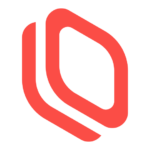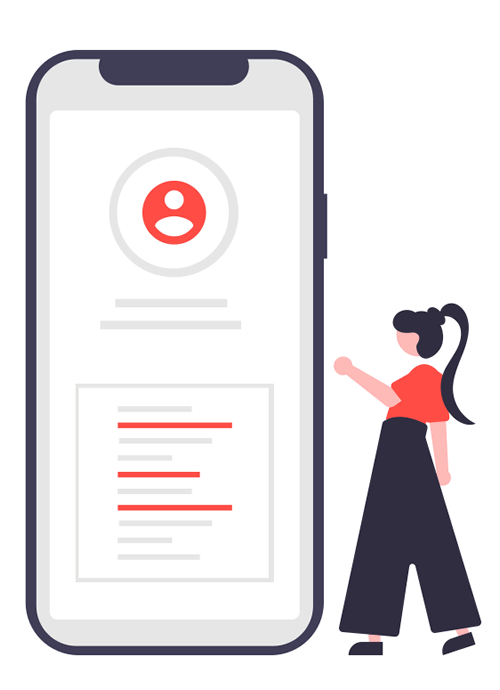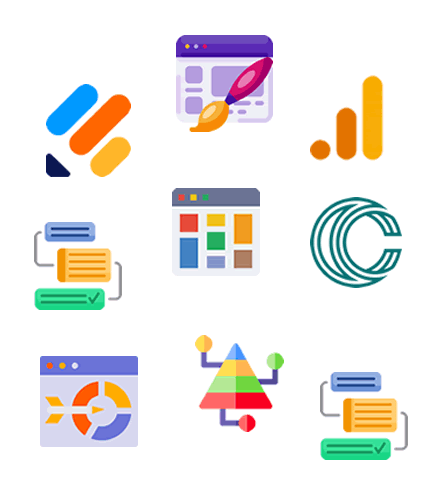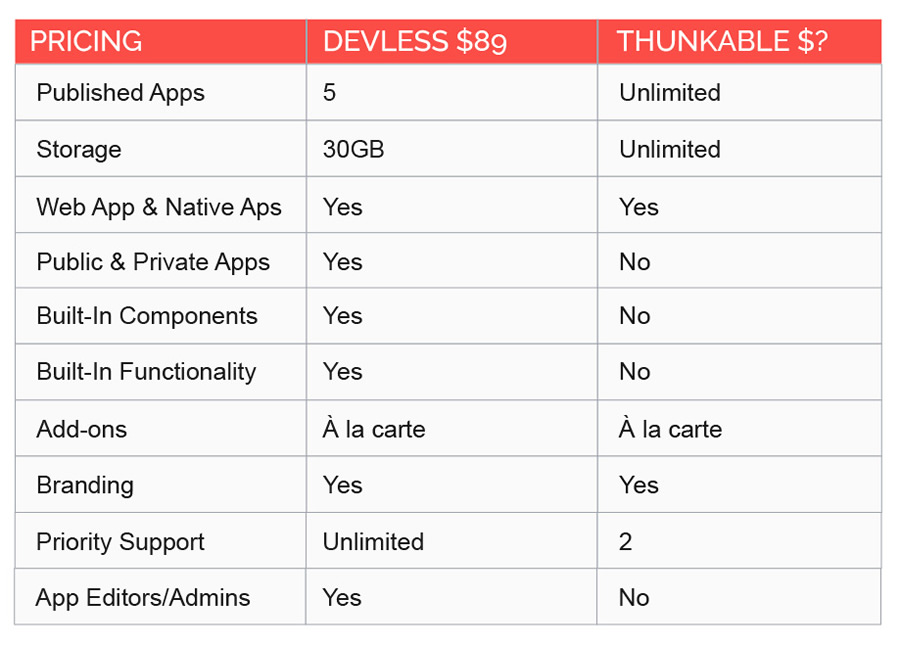Thunkable vs Devless: A No-Code App Builder Comparison
Looking for the right no-code app builder? Devless is the best choice for business owners wanting ease of use and fast app development. Both platforms are user-friendly tools that empower entrepreneurs to customize and develop apps with no coding required. However, there are major differences that you should know before diving deep into app development. Here, we'll share what you can expect by exploring Devless and Thunkable — from setup to pricing.


#1 App Setup: Private Apps are Seamless with Devless
App setup is quick and straightforward on either platform. You begin by naming your app (or project) and start creating it right away. The biggest difference is their default app types. Devless apps start as private apps, and Thunkable apps start as public apps.
A private app means end users will need to register for your app and log in to access it. Devless's secure user registration and login processes are already conveniently built for you, so there's nothing you need to do! From the moment you sign up for any Devless plan, you can share your app and manage registered users from a single page.
Even more, Devless doesn't limit the number of registered users you can have on any plan! Should you decide to make it public later on, you can make the switch instantly from within Settings. Going forward, the login and sign-up screens will simply no longer show to visitors.
With Thunkable, anyone can access your published app since its public. Registration/login would not be required for end users. If your goal is to have a private app with Thunkable, you'll have to upgrade to a paid subscription that allows it. This is pretty common among app builders since private apps are normally considered a premium feature.
From here, you still have to build login and registration screens, add the code, set authentication, and more. Although there are Thunkable tutorials to help you with this, it's not an ideal choice for most business owners with no building experience. This is why Devless apps have done it all for you and at no extra cost.
#2 User Interface: Devless UI is Unmatched in Simplicity
Once your app has been named, your dashboard loads. Most app builders have unique drag-and-drop interfaces, as is the case for Thunkable, but not Devless. Due to the complex menus of this type of UI, your app development will generally take a lot longer. Now, let's dive into each.
Devless gives its users a better experience with an easy, streamlined dashboard that contains only a single left-hand menu for everything. It also lets you slide the menu out of the way for a full-screen workspace.
The most convenient feature of Devless is its form-based UI which gets everyone up and running fast with little to no learning curve. In fact, if you've ever completed a simple online form and are familiar with adding files and folders, then you can build an app with Devless! Its ease of use drastically reduces development time and offers many other significant benefits that we'll touch on below.
In comparison, Thunkable's dashboard is far more complicated. Once you open a project it presents the app editor. In the middle, you can see a visual of your mobile app. There are two tabs, each for the design editor and the block editor. The design editor has a left-hand menu for drag-and-drop components and a right-hand menu for settings. Its block editor has a single left-hand menu that consists of UI components, core, and app features with a large workspace to the right. The menus are all static and you cannot enlarge your workspace.
This is why the Devless UI is hard to beat. Business owners and non-coders love it for its intuitive form-based UI, single menu, and large workspace. With that said, let's take a look at what your experience would be like when you start the app design process on each platform.

#3 App Design: Devless Apps are Automatically Responsive
After getting familiar with your app builder's UI, the next step is to design an app and make it responsive for all devices. You should know upfront that Thunkable does not offer responsive web apps unless you have a Business Plan. In other words, on lower plans, only a phone app can be developed. This leaves a lot to be desired if your audience frequently uses tablets or desktops. In this case, viewing your app on a desktop will show a phone frame in the center of your screen. Such an odd view may be acceptable for personal apps, but it is not appropriate from a business perspective.
Beyond responsive concerns, designing in Thunkable requires that you add components to each screen of your app…like buttons, labels, lists, web views, etc. Even for simple apps, it's a tedious process. We recommend watching app design how-to videos for learning UI best practices should you choose a drag-and-drop builder.
To help out, Thunkable allows you to search existing community projects on Thunkable that might be of use to you. It's easy to copy others' projects and customize them to your liking. Now is a good time to mention that every public app made in Thunkable (including yours) becomes available in their Project Gallery for anyone to view and remix a copy for themselves.
The downside of this is that many of the community app projects are incomplete and/or lack descriptive names for easy search (“SYQ-29” is a fine example). As a result, using search often doesn't return what you hope to find for one reason or another. For a better option, let's look at how Devless makes it all easier.
Since Devless is hyper-focused on usability and saving you time, the design element of app building has pretty much been done for you! UI best practices, every page, and each component are automatically in place as you build out your app…all you have to do is add content, select layouts, etc. And best of all, every Devless plan displays responsive apps. You don't have to upgrade or learn the difficult aspects of how to design your own app in a responsive way!
#4 Programming Functionality: Devless is Easier for Beginners
After the design phase, the next step is to make your application function so users can interact with it. Programming functionality is the most challenging part of app building and is the reason many users never finish their apps. This is why no-code tools have become the best app builders for beginners, but some make it more difficult than it has to be.
In Thunkable, programming is done via a block editor. A block editor is a basic form of visual programming in which you connect logic blocks to tell your app what to do instead of writing lines of code. These days, kids in elementary school are learning to code using block editors so they really are pretty easy!
In that sense, Thunkable apps aren't 100% no-code. You still have to program every component added in the design phase block-by-block to make them come to life. In addition, you'll also have to choose and connect an appropriate database for storage, scalability, and security.
With Devless, there's no worry about learning another editor, managing a database, or programming components. All you do is add resources (your content) and use plugins to tell your app what to do with those resources.

#5 Customization: Grow with Devless Add-ons
App development isn't complete unless you've considered integrating into your app with other no-code tools that can benefit your business and your audience. Including them in your app is possible with both Devless and Thunkable. This is done by using the APIs from other services to extend your app's functionality. Some great examples are Jotform, Google Analytics, and UserWay APIs that allow you to incorporate custom forms, analyze data, or offer accessibility.
The key difference here is that Devless provides a more intuitive way of integrating. You simply enable the add-on, create an external account with the service, and enter its API key into Devless. That's it! Apps are instantly connected. In addition to 3rd party integrations, there are customizable features exclusive to Devless that engage and serve audiences. For Tagging and Guided Support, you just enable them to give your app an edge.
Integrating services in Thunkable is not as easy as Devless. It involves creating the API component yourself, editing properties, setting query parameters and headers, and more. While they have great documentation, if you've never done it before you might stress from the process.

#6 App Store Publishing: Get the Most Out of Your App
Finally, the most rewarding part of app development is the sense of accomplishment you get from seeing your first published app! Can you imagine what it will feel like to see your app in the app stores? With only one build, both support teams give you an Android app in the Google Play store and an iOS app in the Apple App Store. At this point, it may seem like you've crossed the finish line, but a new phase is just beginning. With such a massive reach you'll get plenty of user feedback which will prompt further improvements, new features, and fixes.
#7 Analytics: Only Devless Gives You Insights Effortlessly
As mentioned, you can integrate Google Analytics with your app on either platform, but only Devless offers a built-in analytics page so you can easily see how your published apps are performing. Enjoy amazing visuals like heatmaps for quick insights into activity and user login sessions without any effort on your part.
#8 App Support: Feel Confident as an App Developer
As a beginner using either software, you can rely on extensive tutorials, help docs, and videos to guide you through any tough issues. Other options include direct support by phone, email, and community depending on the platform. We highly recommend scheduling a free demo or a consult for the best start. To schedule with Devless, just go to the homepage and click the 'DEMO' button at the top.
#9 Free Plans: Publish Your Ideas for App Audiences
Wondering how to make apps for free? You can quickly sign-up for a Devless or Thunkable account without a credit card and start building today. Keep in mind there are some limitations with free plans.
For instance, Thunkable does not allow publishing, certain types of support, collaboration, custom branding, private apps, responsive apps, or even tablet views of apps. But no worries, none of these restrictions apply to free Devless apps!
#10 Paid Plans: Devless Offers Price Transparency
Each app builder offers tiered plans for personal or business needs. While Devless offers transparent pricing, the cost of Thunkables's Business Plans aren't published. You'll have to schedule a call to find out. (An article by Bubble states they run about $170/mo on their annual plan.) Whatever their price may be, here's how each builder's Business Plan stacks up.

*Per Thunkable website, additional costs include a maintenance fee for the use of certain components, such as in-app ads by AdMob and a small processing fee for in-app payment via Stripe.
Conclusion:
Choosing a simple no-code app builder is essential for beginner developers to make quick progress. It's important to know the scope of your project and to understand the software's capabilities plus its general approach to app development before you get started. No-code development doesn't always mean easy and fast! There can often be steep learning curves with these platforms.
Being focused on ease of use, Devless's intuitive form-based UI can make all the difference in your ability to successfully create a great app. You'll have the confidence to finish any app you start within a short period. It feels natural to use and avoids the complexities of designing and programming that you'll otherwise encounter with other builders. Plus, its flexible framework and powerful integrations accommodate all kinds of small businesses. See what Devless can do for you and launch your no-code app today!
